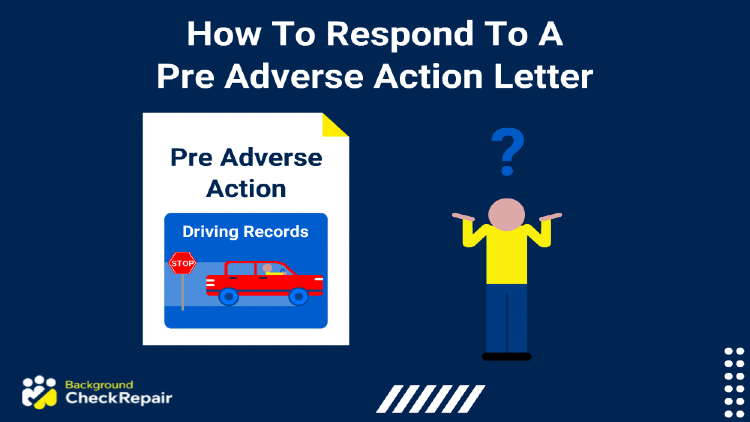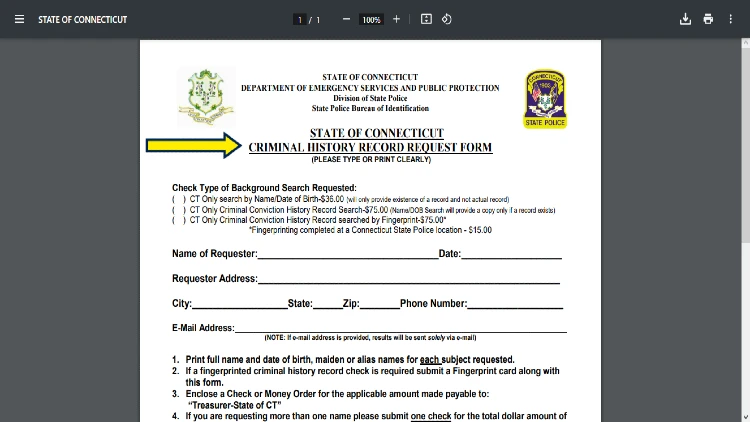
Learning how to respond to a pre adverse action letter is crucial for anyone in the job market, because the sooner the response is issued, the sooner the entire things can be cleared up.
Employers are mandated by the law to send a candidate an adverse action notice if they decide not to move forward with a job application after an employment background screening.
Fortuntely, the process follows clearly defined guidelines, so there are steps that can be taken immediately by the recipient.
The first thing to do immediately, is to get a no-cost criminal records check.
With this information, applicants can find out exactly what a background investigation may reveal and then work to remove any disqualifying information.
If an employer wants to rescind a job offer for a potential employee, they must follow three crucial steps. First, they send a pre-adverse action letter; next, they allow a waiting period, and finally, they send an adverse action notice.
Here’s how to respond to a pre adverse action letter, right now.
How To Respond to a Pre-Adverse Action Letter (How Do You Respond to a Pre-Adverse Action)?
Even though the people involved in hiring wish for the process to move smoothly, this is not always the case. The pre-employment background check may reveal information incompatible with the company or the open position. In this case, the hiring manager will have to deny an applicant’s employment offer.
The law forbids an employer from revoking an offer of employment without notice.1 The adverse action process has several predefined steps. It is essential to understand these steps to learn when and how to respond to a pre-adverse action letter.
1. Pre-Adverse Action
Once an employer uncovers incriminating information during a background check that prompts them to decline an applicant, the employer must give an applicant a written notice (Pre-adverse action letter). This letter can be either a hard or a soft copy.
Pre-adverse action aims to inform applicants that the information found during the pre-employment background check has disqualified them from the position. This letter is delivered along with a copy of the results of the background check and a list of the applicant’s rights under the Fair Credit Reporting Act.7
The applicant is advised to act once they receive the pre-adverse action notification. The law allows them to ensure the accuracy of the background check information, defend themselves, or contest misrepresented data.
2. Waiting Period
According to the FCRA, the employer is required to wait for a reasonable period before sending the official adverse action letter to the applicant. This period is usually more than five working days after sending the pre-adverse action letter.
The waiting period’s objective is to provide the applicant enough time to contest any inaccurate information found in the report or plead their case with the employer. During the waiting period, applicants may be lucky enough to convince the employer to move forward with their application.
3. The Adverse Action Notice
If the employer decides not to move forward with the application despite the candidate’s response to the pre-adverse action letter, they will have to send an adverse action notice. The employer is free to rescind their offer of employment due to background check results. The hiring manager will send an official adverse action notice explaining the reason for their decision in full.
The notice is sent either electronically or as a hard copy. It should have the following properties:
- The notice should include a summary of the FCRA rights that protect the applicant and allow them to directly dispute any incompleteness or inaccuracies of the background check results with the agency that conducted the screening.
- The letter should provide the applicant with a notice of adverse action
- It must also provide contact information for the Consumer Reporting Agency that made the report.
- It should also specify that the employer is solely responsible for the hiring decision, not the contractor.
Adverse Action Compliance Regulations
Besides federal mandates, employers are subjected to several requirements for adverse action notification under ban-the-box laws or state and local fair chance. These restrictions aim to eliminate discrimination against ex-offenders during the hiring process.
Specific jobs such as those in the healthcare or financial industry are ineligible for ex-offenders. However, state and local regulations, as well as federal laws on equal employment opportunities, forbid employers from excluding applicants solely based on past legal issues.2 An employer may be sued if they do not obey these laws and the FCRA.
Most lawsuits concerning FCRA result from two key violations: the employer did not adhere to the adverse action process. They did not provide compliant disclosure and authorization forms after the background check.
What Should an Applicant Do After They Receive a Pre-Adverse Action Letter?
Anyone who receives a pre-adverse action notice when applying for a job or promotion will most likely be disappointed. This is understandable because a pre-adverse action letter indicates that it is more likely than not that the application will move forward.
However, it is essential to note that a pre-adverse action letter indicates that there is still hope. The waiting period, which usually lasts five working days or more, is for the applicant to contest the background check results and address any concerns.
1. Run a Self-Background Check (Critical First Step of How to Respond to a Pre Adverse Action Letter)
It’s crucial to learn how to have a records check performed on yourself. This step will allow an applicant to control the direction of their career. Additionally, this process will enable applicants to catalog their criminal records, driving records, and credit history. This way, the potential employees will continuously verify and correct their records and look out for any disqualifying offenses.
Applicants are advised to run several kinds of background checks on themselves. A level 2 background screening is the most common screening run by employers nationwide. A level 2 screening primarily focuses on a person’s criminal history. Therefore, it’s imperative to learn how to check for your criminal background or history.
Where Do Applicants Find Their Records?
Conducting a self-background check will help a potential employee learn what to expect. There are several ways to perform this process. The applicant can use professional services to complete the screening. Some are free, but most require a small fee.

On the other hand, criminal records are available to the public through law enforcement agencies. Here, the applicant can access conviction and arrest records. Applicants should look through it.
- Departments of Public Safety
- FBI
- Bureaus of Investigations
- Local Police Departments
- State Police
How Can Applicants Correct Their Records?
Many Americans have something incriminating on their records. Therefore, a spotty record should not be a reason to despair. There are several steps that an applicant can take to clean their records. The local law enforcement agencies provide avenues through which an applicant can correct erroneous information.
Alternatively, applicants can get rid of their criminal records from background screening through a process known as record removal or expungement.3 This refers to a legal procedure that removes certain convictions, either felonies or misdemeanors, from a person’s criminal history. Records can be expunged if the offender has served their sentence, the crime was conducted a long time ago (7-10 years), or the nature of the crime allows expungement.
With over 100 million Americans having something on their records, an applicant that learns how to remove a criminal record from a background check will be a step ahead of the rest. The applicant may choose to have their records sealed which will prevent public access and thus, will not come up during a background check.
2. Review the Background Check Report
A pre-adverse action letter will usually accompany a duplicate report of the background check information. The applicant is advised to review this report carefully to ensure it aligns with the self-background check report. The information in this copy must accurately represent the applicant’s history.
The applicant should not make any errors in the report. Then the applicant must collect any evidence of this error, such as legal documents or contact information of people that can be used as references to correct the mistakes.
Once the applicant has all the evidence they can gather, they should contact the employer or hiring manager to determine how to deliver this information. The employer must review this information to decide whether or not it changes their mind.
4. Address Any Disqualifying Offense
In most cases, the background check will accurately display convictions or criminal history records. If this is the case, the applicant should address these issues directly.
- The applicant should be upfront and honest about the criminal history
- They should explain how they’ve served their debt to society or learned from experience. Some crimes, though incriminating, are not a hindrance to thriving in the new position.
- Describe any new training or skills that are relevant to the position
- Consider adding this information (lesson learned etc.) on a personal note and sending it to the employer.
- Familiarize with FCRA rights, fair chance, and ban-the-box laws ahead of time to prevent any discrimination in the process.
What Is a Pre-Adverse Action Letter (Pre-Adverse Action Notice)?
A pre-adverse action letter refers to the notice a hiring manager or employer gives to dismiss or demote an applicant from a position.4 The hiring manager provides this notice after conducting a background check and finding information deemed grounds for declining the candidate. A pre-adverse action letter also includes:
Employment Status Notice: The first thing an adverse letter does is to inform the candidate about the employer’s decision regarding their employment status and how it is affected by the background report. This notice will highlight whether the employer is moving forward with the application and in what capacity.
Background Report: The pre-adverse notice must include a background check report to justify the employer’s reasoning behind the decision. This report allows the candidate to review it thoroughly and note any errors.
Summary of Rights: According to the law, employers must include an overview of the applicant’s rights according to the FCRA.
The candidate will receive reasonable time to go over the report and tackle any inaccurate information. Additionally, the applicant will get a chance to clarify the incorrect information and explain the findings in the report. The goal of a pre-adverse action letter is to alert the applicant that the hiring process may not go their way. Moreover, this notice allows the applicant to change their final verdict.
Pre-Adverse Action Letter Example
Here is an example of a pre-adverse action letter:

Can I Be Hired After Pre-Adverse Action?
Employers can still move forward with the application of a candidate who has received an adverse letter depending on the situation. First, it’s important to note that the hiring manager issues a pre-adverse action letter to address a few actions, including:
- Declining a candidate
- Dismissing an employee
- Demoting a current employee
- Offering a less senior position to the candidate
Consequently, in some cases, even though an adverse action has been issued, the final result may involve a candidate getting hired to perform a different position than the one they applied for.
Moreover, pre-adverse action notices are only the first step in the adverse action process. If the applicant reviews the background check report, finds errors, and successfully contests the results during the waiting period, then the adverse action will be nullified. In this case, the candidate is still eligible for consideration and will maintain the offer depending on the employer’s preferences.
The role of a pre-adverse action notice is not to automatically disqualify an applicant.5 Instead, it gives the applicant an opportunity to ensure that they do not undergo a negative employment action due to incorrect information on the background screening report.
Furthermore, this notice ensures fairness in the hiring process because the applicant can present some evidence regarding inaccurate information or explain any incriminating evidence that appears on their records.
The employer is not trying to work against any potential applicant. If the candidate is eligible for the position, an adverse employment action should not impinge on them, especially if the background check report contains wrong information.
What Happens If I Have a Failed Background Check After Starting Job?
The company can still terminate an employee who has failed a background check. Most companies want to ensure that what the applicant has claimed on their application form or resume is accurate. They will verify an individual’s:
- Criminal history
- Credit History (credit report)
- Education Credentials and Job Certifications
- Employment history
Sometimes, the hiring manager will review a person’s social media to verify whether they will affect the brand’s reputation.
It’s important to note that some employers are more lenient if the applicant is upfront with any incriminating information. If the background check reveals any information that correlates with what the applicant gave, then there will be no issue.
In most cases, however, failing a background check will mean that the applicant needs to find a different job.6 A disqualifying offense in one hiring process may not hold the same magnitude everywhere. Therefore, the applicant shouldn’t lose hope.
Some employers are more lenient and open to providing second chances, while the law restricts others from discriminating against a person’s criminal history.
There are four steps to consider to pass the next employment background screening:
- Conduct a Self-Background Check: This is the first step in learning how to respond to a pre adverse action letter. Notably, the applicant must learn how to obtain a criminal history report. Here, the applicant will get a chance to see what prospective employers see when they examine a person’s history.
- Understand which jobs you are ineligible for: Certain crimes automatically disqualify applicants from specific jobs. Therefore, candidates should focus on applying for jobs they are more likely to get.
- Be honest: One of the most significant disqualifying offenses in the job market is dishonesty. Applicants should not lie on their job application, resume, or interview.
- Consider Expungement: Applicants can consider getting their records sealed or expunged. It’s an arduous process, but once complete, incriminating records will not appear in the next background check.
In summary, a pre-adverse action letter indicates that the employer has found something incriminating in an applicant’s background check and may not proceed with the employment application. However, this letter allows the applicant to contest this decision before the final verdict (adverse action) is made. Therefore, it’s important to learn how to respond to a pre adverse action letter.
Frequently Asked Questions About How To Respond to a Pre Adverse Action Letter




